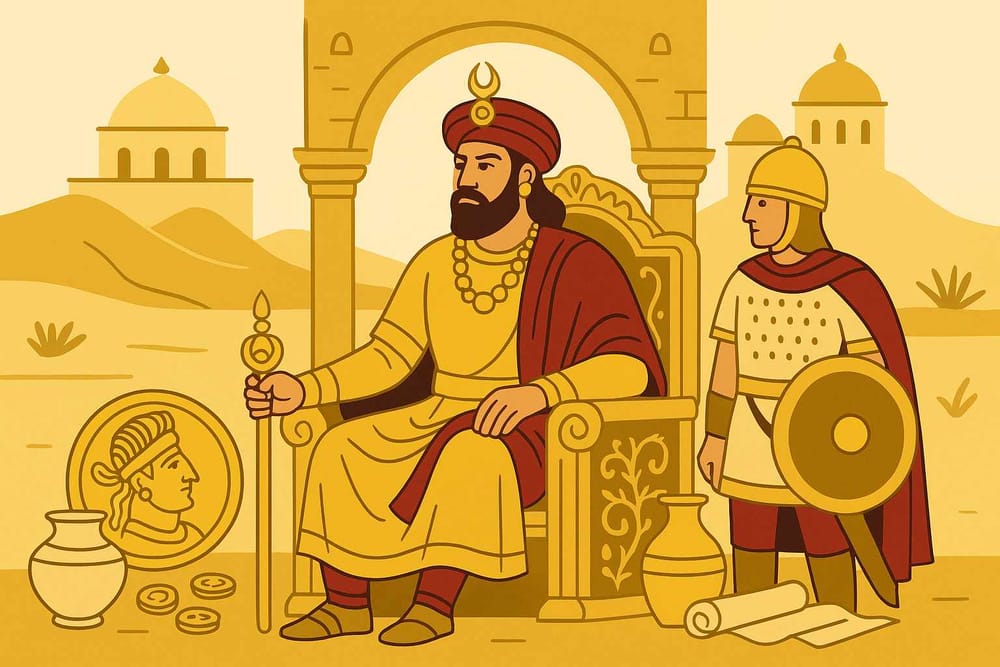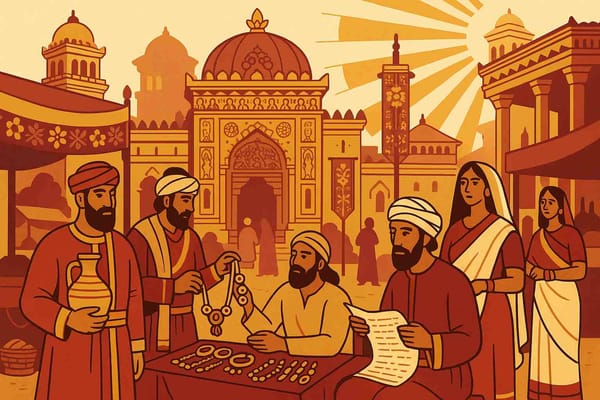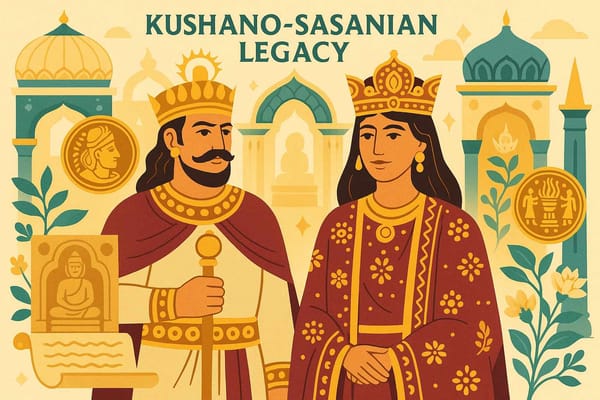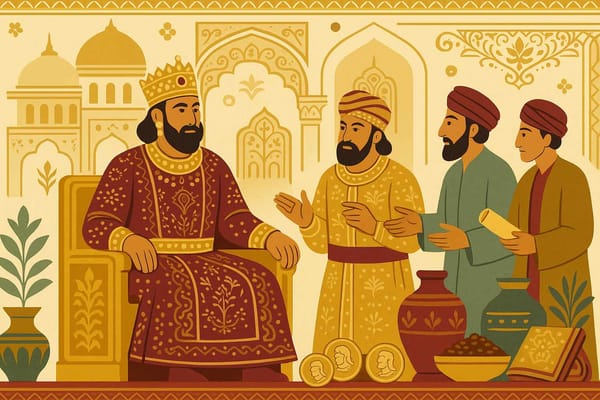
Kushano-Sasanians: Explore This Missing Chapter in Ancient History
Sometimes, in the grand book of history, certain chapters get quietly turned over, their stories fading between the pages of larger, more famous empires. It’s like a family recipe that no one wrote down, its unique flavour remembered but not fully known. The story of the Kushano-Sasanian Empire is one such forgotten chapter, a beautiful tale of a cultural 'sangam' that once thrived at the crossroads of ancient India and Persia.
For those of us who cherish our roots, understanding these lesser-known histories is like finding a missing piece of our own identity. It helps us see the full, vibrant tapestry of our heritage. So, let’s take a journey back in time to explore this fascinating empire that blended two mighty civilisations.
The Dawn of a Hybrid Empire: When Two Worlds Met
In the 3rd century CE, the mighty Kushan Empire, which had ruled over large parts of northern India and Central Asia, was facing turbulent times. Internal struggles and external pressures were weakening its hold. Seeing this opportunity, the ambitious Sasanian Empire from Persia, under visionary rulers like Ardashir I and Shapur I, began to expand eastward.
This wasn't just a conquest; it was the beginning of something entirely new. The Sasanians took control of vital regions like Bactria (in modern Afghanistan) and Gandhara. The Sasanian governors appointed here were given the title "Kushanshah," meaning 'King of the Kushans.' This title itself shows the respect and integration that was happening. They didn't just impose their rule; they created a unique hybrid governance system that wove together Persian administrative strength with local Kushan traditions. This new political power became known as the Kushano-Sasanian or Indo-Sasanian kingdom.
A Realm Built on Trade and Tradition
The strength of the Kushano-Sasanian empire wasn't just in its military might, but in its brilliant fusion of different cultures and its economic savvy. They created a society that was both stable and prosperous.
One of the most telling artifacts from this era is their coinage. These coins were like little messengers of unity, featuring a mix of Sasanian and Kushan symbols and scripts. Found in places like Kabul, Balkh, and Herat, they tell a story of a realm comfortable with its dual identity, using these coins for both trade and to declare their unique political standing.
Their location was their biggest asset. Ruling over key parts of the legendary Silk Road, the Kushano-Sasanians became the gatekeepers of a bustling trade network. Imagine caravans carrying silk, fragrant spices, and precious metals passing through their lands, connecting the Roman world with China and India. This not only brought immense wealth but also a constant flow of new ideas, philosophies, and art, making their kingdom a true melting pot of civilisations.
A Beautiful Jugalbandi of Faith and Art
When cultures meet, the most beautiful outcome is often seen in art and spirituality. The Kushano-Sasanian period was a golden example of this. It was a time of incredible religious harmony where Zoroastrianism from Persia, and Buddhism and Hinduism from the Indian subcontinent, all coexisted peacefully. This acceptance of diverse beliefs created a rich spiritual environment.
This cultural blend is visible in their art and architecture. Imagine sculptures where the regal style of the Sasanians merges with the gentle, spiritual art of the Kushans. This fusion created a unique aesthetic that was all its own. They acted as a cultural bridge, and it was during this time that Buddhist art and texts travelled further along the Silk Road, leaving a lasting impact on Central Asia and beyond. This reminds us of the deep-rooted spiritual connections that define India's sacred geography and its cultural impact.
Why This Forgotten Story Matters Today
You might wonder, if this empire was so significant, why is it often just a footnote in history books? The truth is, it was often overshadowed by its larger parent empires, the Kushans and the Sasanians. However, its legacy is profound. This empire served as a vital bridge, fostering a unique identity that influenced the region for centuries. Its hybrid model of governance and its role in fostering trade and cultural exchange left a lasting mark.
The Kushano-Sasanians eventually faced challenges from invading groups like the Kidarites and Hephthalites, which led to their decline by the 5th century. But their story teaches us a powerful lesson about the strength found in adaptation and cultural exchange. It’s a reminder that our history is not made of isolated kingdoms but of interconnected stories of people coming together, sharing, and creating something new and beautiful.
Connecting with Our Living Heritage
Exploring stories like that of the Kushano-Sasanians helps us appreciate the depth and complexity of our own heritage. It shows us that our culture has always been dynamic, welcoming, and enriched by diverse influences. This act of discovery, of piecing together the past to understand our present, is a deeply fulfilling spiritual journey in itself.
At Bhaktilipi, we believe in this very journey. Our mission is to preserve and share the timeless devotional literature and stories that form the soul of our culture. We see ourselves as curators of this spiritual virasat, ensuring these treasures are not forgotten.
How Bhaktilipi Can Be a Part of Your Journey
- Explore Our Collection: We bring you devotional works from various regions and languages, many of which are rare or hard to find. By digitising and presenting them beautifully, we make sure this wisdom remains accessible for you and for generations to come.
- Connect with Timeless Wisdom: Our platform allows you to delve into spiritual insights and inspiring stories that can enrich your daily life and deepen your connection with bhakti traditions. It's a space to nourish your soul.
Join our community in celebrating and exploring the beauty of bhakti. Stay connected with us for regular inspiration and updates on our work.
A passionate group of people dedicated to preserving India's knowledge of Dharma, Karma, and Bhakti for ourselves and the world 🙏.
Comments
Related in

The Kushano-Sasanians- Explore the Empire's Secrets
Sometimes, the most fascinating stories of our motherland are not the ones we learn in school. We talk endlessly about the Mauryas, the Guptas, and the Mughals, but history has countless hidden chapters, tucked away in the sands of time. One such incredible tale is that of the Kushano-Sasanians, an

Exploring the Legacy of the Kushano-Sasanians: History and Impact
History isn't always about grand battles and massive empires that we read in school textbooks. Sometimes, the most beautiful chapters are written in the quiet spaces in between, where cultures meet, shake hands, and create something entirely new. Imagine a time when the powerful Persian Sasanian empire extended

Kushano-Sasanians- A Forgotten Era of History Explained
History, as we often read it, is a grand narrative of mighty empires and legendary conquerors. But sometimes, the most fascinating tales are hidden in the folds, in the chapters that speak not of conquest, but of confluence—a beautiful sangam of cultures. One such forgotten story is that of
